Have you ever opened a bag of dry dog food only to find it stale, rancid, or infested with bugs? If so, you’re not alone. How to store dry dog food properly?
If you are a dog owner, you know how important it is to provide your furry friend with the best nutrition possible. One of the key aspects of this is proper storage of their dry dog food.
Storing it incorrectly can lead to spoilage and loss of nutrients, which can harm your pet’s health.
In this post, I’ll share my top tips for storing dry dog food properly to ensure it stays fresh and tasty for your furry friend.
How To Choose The Right Container For Storing Dry Dog Food?
Choosing the right container to store your dog’s dry food is crucial to ensure its freshness and quality. There are various types of containers available in the market, but not all of them are suitable for storing dry dog food.
It’s important to choose a container that is airtight and made of high-quality materials to prevent moisture and air from entering it.
The most common types of containers used for storing dry dog food include plastic, metal, and glass containers.
Plastic Containers
Plastic containers are popular among pet owners due to their affordability and durability. They come in different shapes and sizes, making it easy to find one that suits your needs.
However, not all plastic containers are safe for storing food as they may contain harmful chemicals that can leach into the food over time.
It’s essential to choose a BPA-free plastic container that is specifically designed for storing pet food.
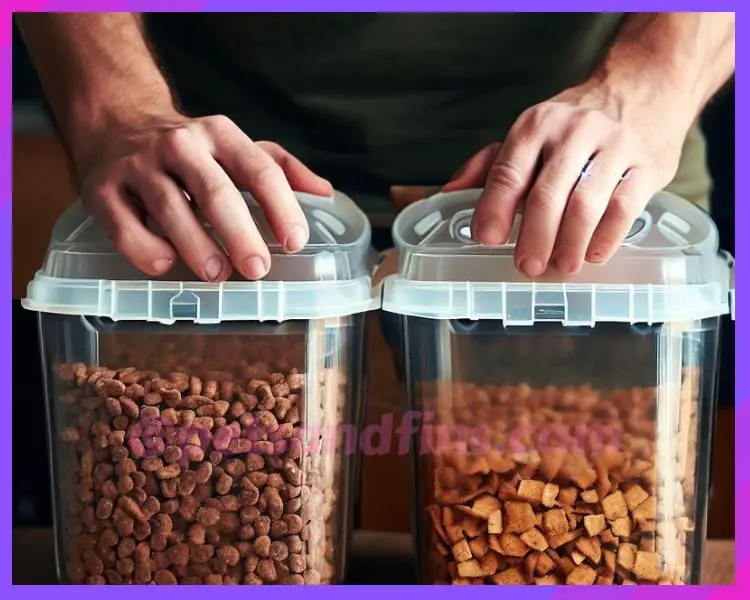
Metal Containers
Metal containers are also an excellent choice for storing dry dog food as they’re durable and can keep the food fresh for longer periods.
However, metal containers can be prone to rusting if they’re not made of high-quality materials or coated with rust-resistant materials.
It’s important to choose a metal container that has an airtight seal and is made of stainless steel or other rust-resistant metals.
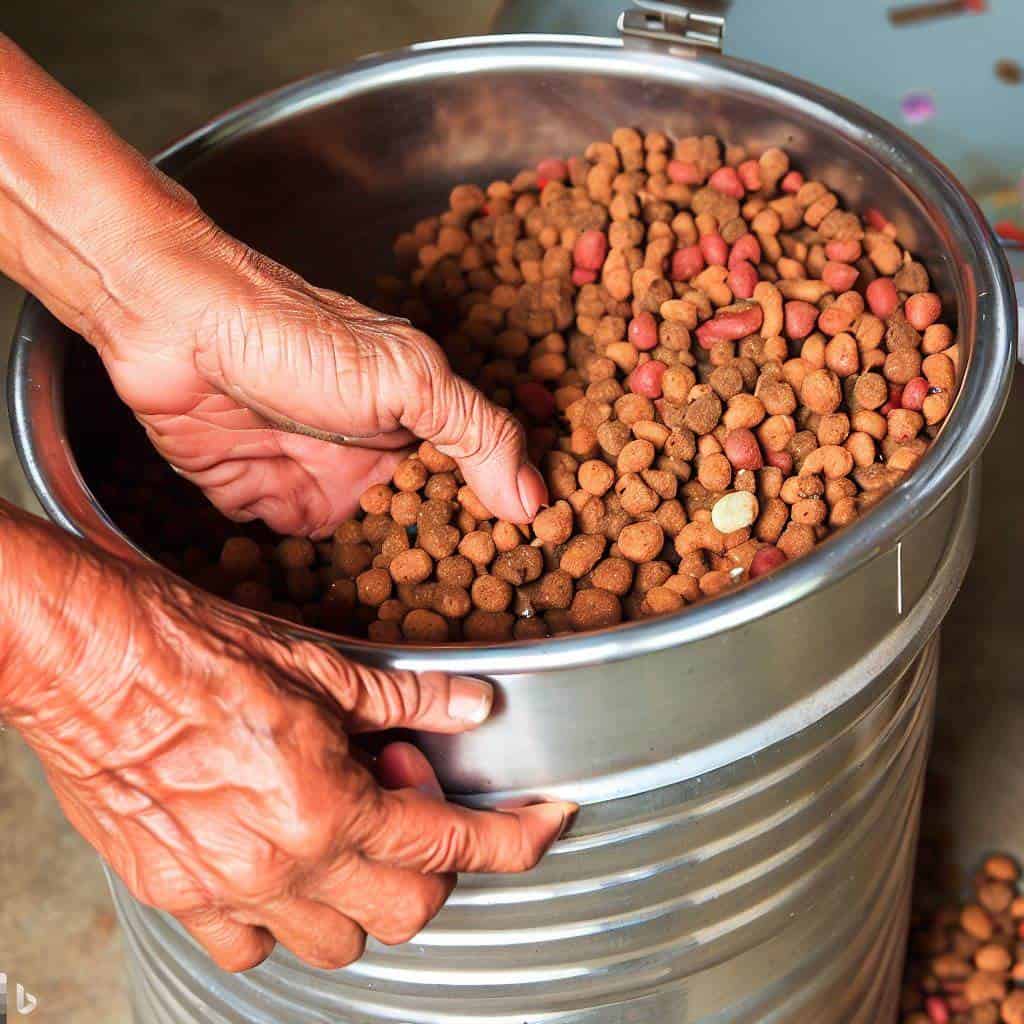
Glass Containers
Glass containers provide an excellent option for pet owners who want an eco-friendly solution for storing their dog’s dry food.
Glass doesn’t contain any harmful chemicals like plastic does, making it safe for storing food.
Glass jars or canisters with tight-fitting lids work well as they allow you to see how much food is left inside while keeping it fresh.
When choosing a container, make sure it’s large enough to hold your dog’s entire bag of dry kibble while leaving some room at the top.
This will allow you to scoop out the kibble easily without spilling it everywhere while also ensuring there’s enough space for air circulation inside the container.
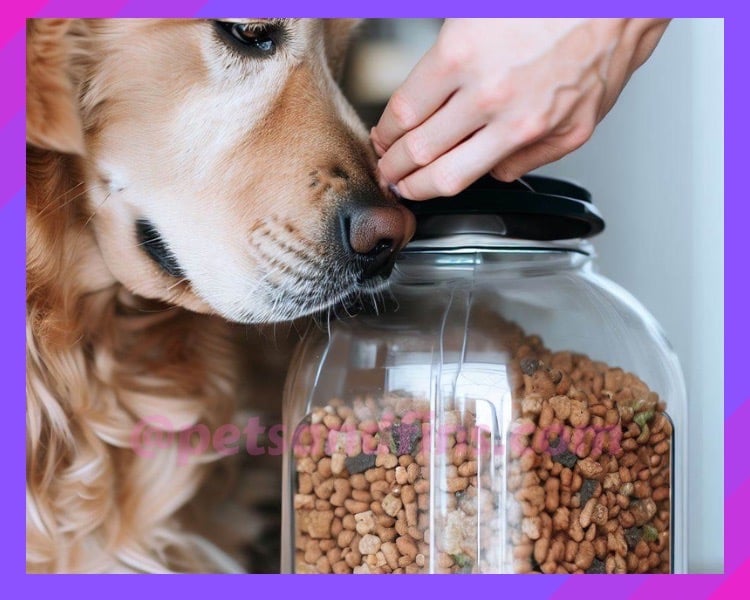
Choosing the right container is vital for storing your dog’s dry food properly.
Whether you opt for plastic, metal, or glass containers, make sure they’re airtight and made of high-quality materials that are safe for storing food.
With the right container, you can keep your furry friend’s food fresh and delicious for longer periods while ensuring their health and well-being.
Tips To Choose The Best Dry Dog Food Storage Container
With so many options available, choosing the best storage container for dry dog food can be overwhelming. Here are 13 tips to help you make the right choice.
1. Consider the size of your dog
The size of your dog will determine how much food they consume. Choose a container that can hold enough food for at least one week.
2. Look for an airtight seal
An airtight seal will prevent air and moisture from entering the container, keeping the food fresh for longer.
3. Check for BPA-free materials
Bisphenol A (BPA) is a chemical commonly found in plastic containers that can be harmful to dogs if ingested over time.
4. Opt for opaque containers
Opaque containers will block out light, which can cause the food to spoil faster.
5. Choose a durable material
Dogs can be rough on their toys and accessories, so choose a container made from sturdy materials such as stainless steel or heavy-duty plastic.
6. Consider portability
If you travel frequently with your dog, choose a lightweight and portable container that is easy to carry around.
7. Look for easy-to-clean options
Choose a container with smooth surfaces that are easy to clean and won’t trap bacteria or odors.
8. Check for pest-proof features
Some containers come with pest-proof features such as locking lids or tight-fitting seals that prevent insects and rodents from getting into the food.
9. Avoid using human-grade containers
While it may be tempting to reuse old human-grade containers, they may not be suitable for storing pet food as they may contain harmful chemicals or residues.
10. Don’t store multiple types of food in one container
Mixing different types of food can cause contamination and spoilage, so it’s best to store each type of food in its own container.
11. Consider the shape of the container
Choose a container with a wide opening that will allow you to easily scoop out the food without spilling it.
12. Look for stackable options
If you have limited storage space, choose containers that can be stacked on top of each other to save space.

13. Check for FDA approval
Make sure that the container you choose is approved by the Food and Drug Administration (FDA) for storing pet food.
How To Choose The Best Location To Store Your Dry Dog Food ?
Here are few easy tips to help you choose the best location for storing your dry dog food.
1. Choose a cool, dry place
The ideal storage location for dry dog food is a cool, dry place with low humidity. This will help prevent moisture from getting into the food and causing mold or bacterial growth.
If you live in an area with high humidity levels, consider using a dehumidifier in the room where you store your pet’s food.
High humidity can cause moisture buildup inside containers which leads to mould growth and spoilage over time.
2. Avoid direct sunlight
Exposure to direct sunlight can cause the oils in dry dog food to break down, leading to rancidity and loss of nutritional value.
3. Keep it away from heat sources
Heat can also cause oils in dry dog food to break down, so it’s important to keep it away from heat sources like radiators or ovens.
4. Use an airtight container
An airtight container will help keep out moisture and air, which can both contribute to spoilage and degradation of nutrients.
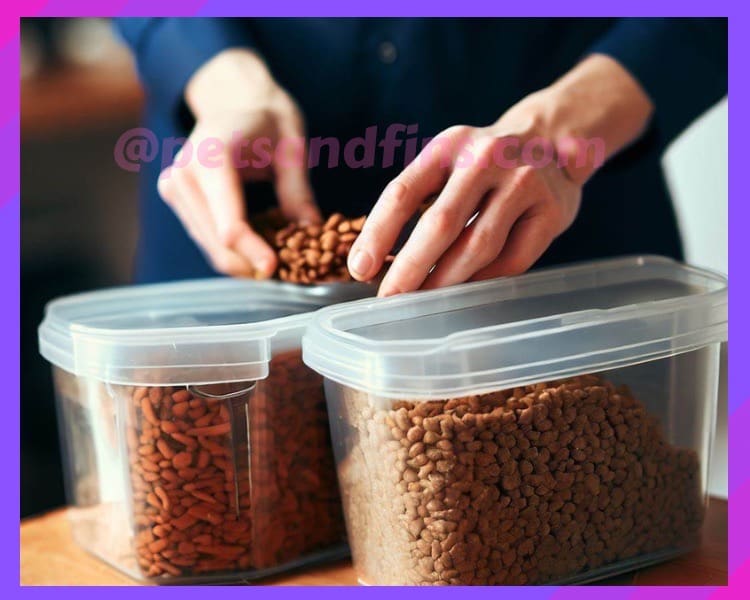
5. Choose a container made for pet food storage
Containers made specifically for pet food storage are designed with features like tight-fitting lids and easy-to-clean materials that make them ideal for storing dry dog food.
6. Don’t use plastic bags
Plastic bags are not recommended for storing dry dog food because they are not airtight and can easily be punctured or torn by sharp edges on kibble pieces.
7. Store away from chemicals
Chemicals like cleaning products or pesticides should be kept far away from your pet’s food as they can contaminate it if spilled or leaked onto it.
8. Keep it off the floor
Storing your pet’s food on the floor makes it more susceptible to contamination by pests like ants or mice, so it’s best to keep it on a shelf or in a cabinet.
9. Don’t store near pet waste
Storing your pet’s food near their litter box or outside in the yard can lead to contamination from fecal matter, which can cause illness if ingested.
10. Keep it out of reach of children
Dry dog food may look like a tasty snack to young children, so it’s important to store it out of their reach to prevent accidental ingestion.
11. Check expiration dates
Always check the expiration date on your dry dog food before purchasing and storing it, and make sure to use it before the expiration date has passed.
12. Use within recommended time frame
Most dry dog foods have a recommended use-by date that should be followed closely to ensure freshness and nutritional value.
13. Don’t mix old and new food
Mixing old and new batches of dry dog food can lead to spoilage or contamination, so always use up one batch before opening another.
14. Store supplements separately
If you add supplements like vitamins or probiotics to your pet’s food, store them separately from the dry dog food to prevent moisture from getting into either product.
15. Rotate stock regularly
To ensure that your pet is always getting fresh, high-quality nutrition, rotate your stock of dry dog food regularly by using older bags first and replacing them with fresh ones as needed.
16. Accessibility
Another important factor to consider when choosing a storage location is accessibility. You want to make sure that you can easily access your pet’s food when it’s time for feeding without having to move other items out of the way.
Overall, choosing an appropriate location for storing your dog’s dry food plays a vital role in maintaining its quality and freshness over time.
By following these simple guidelines, you’ll be able to provide your furry friend with the best possible nutrition while minimizing the risk of spoilage and contamination.
How To Properly Seal Your Dog’s Dry Food ?
As a dog owner, it is important to ensure that your furry friend’s food stays fresh and safe for consumption. One way to do this is by properly sealing the dry food once it has been opened.
Here are step-by-step instructions on how to seal your dog’s dry food:
Step 1: Choose the Right Container
The first step in properly sealing your dog’s dry food is choosing the right container. The container should be airtight and made of a material that will not absorb any odors or flavors from the food.
Plastic containers with tight-fitting lids are a good option, as they are easy to clean and maintain.
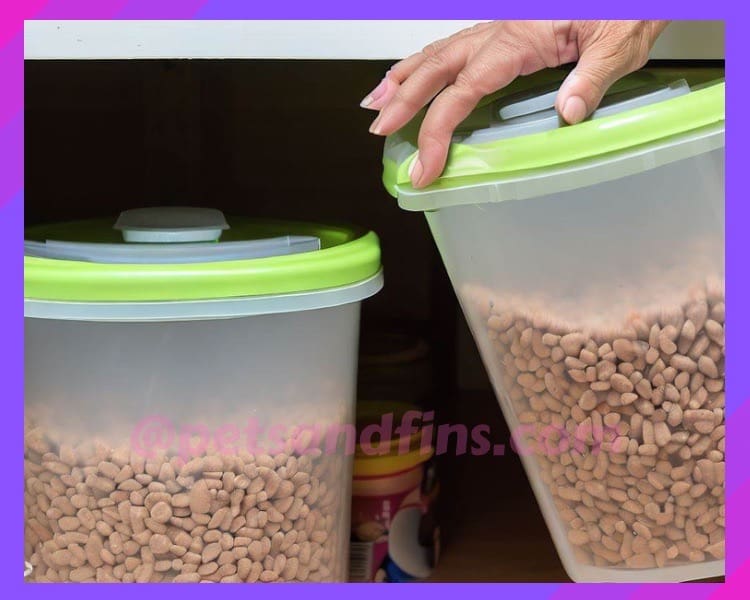
Step 2: Clean the Container
Before transferring the dry food into the new container, make sure that it is clean and free of any residue from previous use. Wash it thoroughly with soap and water, then rinse it well and let it air-dry completely.
Step 3: Transfer the Dry Food
Once you have chosen an appropriate container and cleaned it thoroughly, transfer all of your dog’s dry food into it.
Make sure that you pour all of the contents into the new container, including any leftover crumbs or bits at the bottom of the old bag.
Step 4: Add an Oxygen Absorber (Optional)
If you want to take extra precautions in keeping your dog’s dry food fresh, consider adding an oxygen absorber packet to the new container before sealing it shut.
These packets work by removing any excess oxygen from inside the container, which can help prevent spoilage or mold growth.
Step 5: Seal Tightly
After transferring all of your dog’s dry food into its new home, make sure that you seal it tightly with its lid or cover.
Check for any gaps or openings around the edges of the lid – if there are any gaps present, try adjusting or tightening them until they fit snugly against each other.
Step 6: Store in a Cool, Dry Place
Once you have sealed your dog’s dry food properly, it is important to store it in a cool, dry place. Avoid storing the container in direct sunlight or near any sources of heat or moisture, as this can cause the food to spoil more quickly.
Step 7: Check for Freshness Regularly
Even if you have sealed your dog’s dry food properly and stored it in an ideal location, it is still important to check for freshness regularly.
Open the container and take a whiff of the contents – if there is any musty or rancid odor present, discard the food immediately. Also, check for any signs of mold growth or insect infestation.
15 mistakes to avoid while storing dry dog food
1. Not checking the expiration date: Always check the expiration date on the bag before purchasing or feeding your dog. Expired food can cause digestive problems and even make your pet sick.
2. Storing in a damp area: Moisture can cause mold growth and spoilage of the food. It is best to store dry dog food in a cool, dry place away from any moisture sources.
3. Leaving the bag open: Leaving the bag open exposes the food to air and moisture, which can lead to spoilage and loss of nutrients. Always seal the bag tightly after use.
4. Using a dirty container: If you choose to transfer your dog’s food into another container for storage purposes, make sure it is clean and free from any bacteria or contaminants.
5. Overfilling the container: Overfilling a container can cause air pockets in the food leading to spoilage or contamination.
6. Not using an airtight container: An airtight container helps keep out moisture and air that could damage or contaminate your pet’s food.
7. Storing near chemicals: Chemicals such as cleaning agents or pesticides should be kept away from your pet’s food as they may contaminate it.
8. Mixing old with new: Mixing old with new bags of dog food may cause contamination if there are any differences in quality standards between batches.
9. Storing near heat sources: Heat sources such as radiators or ovens should be avoided as they can cause the food to spoil or lose its nutritional value.
10. Not storing in a cool area: Dry dog food should be stored in a cool area, preferably below 75 degrees Fahrenheit, to prevent spoilage and loss of nutrients.
11. Storing near pet waste: Pet waste can contain harmful bacteria that could contaminate your pet’s food. Always store dry dog food away from any areas where pets relieve themselves.
12. Not checking for pests: Pests such as rodents or insects can easily access dry dog food if not stored correctly. Always check for signs of infestation and take necessary measures to prevent it.
13. Using an old container: Old containers may have cracks or scratches that could harbor bacteria and contaminants. It is best to use a new container when storing your pet’s food.
14. Storing in direct sunlight: Direct sunlight can cause the food to spoil quickly and lose its nutritional value. Always store dry dog food away from direct sunlight.
15. Not using the oldest bag first: When you have multiple bags of dry dog food, always use the oldest bag first before opening a new one to avoid spoilage and waste.
Key Takeaways
In conclusion, proper storage of your dog’s dry food is crucial to ensuring its nutritional value and freshness.
It’s essential to keep the food in its original packaging or airtight containers, in a cool, dry place away from sunlight, moisture, and pests.
By following these simple tips, you can prolong the shelf life of your dog’s food and ensure that it stays fresh and tasty. Remember to check the expiration date and use the oldest bags of food first, to prevent spoilage.
Your dog depends on you to provide them with the best possible nutrition, and storing their food properly is a critical part of that responsibility.
By taking the time to store their food correctly, you can help keep them healthy and happy for years to come.
So, don’t take this task lightly, give it the attention it deserves, and enjoy the peace of mind that comes with knowing you’re doing everything you can to provide your furry friend with the best possible care.
References:
1. American Kennel Club (2019). How to Store Dog Food: Tips for Keeping Your Pup’s Kibble Fresh.
2. PetMD (2020). How to Store Dry Dog Food.
3. Hill’s Pet Nutrition (2021). How to Store Dry Dog Food.
4. Chewy (2021). How to Store Dry Dog Food.
5.American Kennel Club. (n.d.). How to Store Dog Food Properly. Retrieved from https://www.akc.org/expert-advice/nutrition/how-to-store-dog-food-properly/
6.PetMD Editorial. (2018). How to Choose the Right Dog Food Storage Container. Retrieved from https://www.petmd.com/dog/care/how-choose-right-dog-food-storage-container
7. U.S Food & Drug Administration (FDA). (2019). Pet Food Labels – General Information.
-
Is it ok to store dry dog food in ziploc bags?
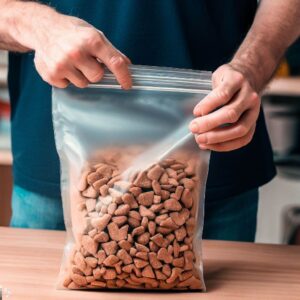
One of the most common questions that pet owners ask is whether it is okay to store dry dog food in Ziploc bags for short periods.
While this may seem like a convenient option, there are several factors to consider before making this decision.Firstly, it is important to understand that dry dog food has a limited shelf life. Once opened, the food can start to lose its nutritional value and freshness over time.
This can lead to health problems for your pet if they consume stale or expired food. Therefore, it is essential to store dry dog food in an airtight container that will preserve its quality for as long as possible.
Ziploc bags may seem like a good option for storing dry dog food because they are easy to use and seal tightly.
However, these bags are not designed for long-term storage of perishable items such as pet food. They are more suitable for short-term storage of non-perishable items.
Another issue with using Ziploc bags for storing dry dog food is the risk of contamination. If the bag is not properly sealed or stored in a clean environment, bacteria and other harmful substances can enter the bag and contaminate the food inside.
This can lead to serious health problems for your pet if they consume contaminated food.
Additionally, Ziploc bags may not be able to protect dry dog food from moisture and humidity. Moisture can cause the kibble to become soggy and stale, which can make it less appealing or even dangerous for your pet’s health.
In conclusion, while Ziploc bags may seem like a convenient option for storing dry dog food in short periods, they are not ideal due to their limited ability to preserve freshness and protect against contamination and moisture.
It is best practice to store dry dog food in an airtight container specifically designed for this purpose. This will ensure that your pet’s food remains fresh and nutritious and that they stay healthy and happy.
If you do choose to store your dry dog food in ziploc bags there are a few things you need to consider.
It is important to note that not all Ziploc bags are created equal. Some bags may be made from materials that are not safe for storing food, while others may not be strong enough to hold the weight of a large bag of dog food.
Therefore, it is essential to choose high-quality, food-grade Ziploc bags that are designed specifically for storing pet food.
You should ensure that the bag is completely clean and free from any contaminants before filling it with dog food. This will help prevent any bacteria or mold from growing inside the bag and potentially contaminating the food.
Additionally, you should only fill each bag with enough dog food for one serving or one day’s worth of meals. This will help ensure that the food stays fresh and does not become stale or rancid over time.
Another important consideration when using Ziploc bags to store dry dog food is how you plan on storing them. Ideally, you should keep them in a cool, dry place away from direct sunlight or heat sources.
This will help prevent any moisture from getting into the bag and causing mold or bacterial growth.
-
Is it ok to store dog food in a metal container?
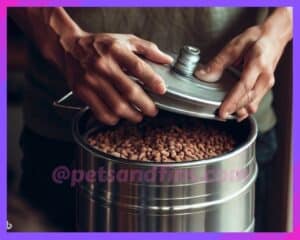
Yes, it is okay to store dry dog food in a metal container as long as it is airtight and clean. Metal containers are durable, rodent-proof, and can protect the food from moisture and light.
However, there are some concerns regarding the safety of storing dog food in metal containers.
One concern is the possibility of metal contamination. If the container is made of low-quality metal or has rusted over time, it may contaminate the food with harmful chemicals such as lead or cadmium. This can pose serious health risks to your pet if ingested.
Another concern is that metal containers may not be completely airtight, allowing moisture and air to enter and spoil the food. This can lead to mold growth and bacterial contamination which can cause digestive problems for your pet.
To avoid these issues, it is recommended that you choose high-quality metal containers specifically designed for storing pet food.
These containers should be made from non-toxic materials such as stainless steel and should have an airtight seal to prevent moisture and air from entering.
In conclusion, while storing dog food in a metal container can be safe if done correctly, it is important to choose high-quality containers made from non-toxic materials and ensure they have an airtight seal.
By taking these precautions, you can help ensure that your furry friend’s meals remain fresh and nutritious for longer periods.
-
Is it ok to store dog food in a plastic container?
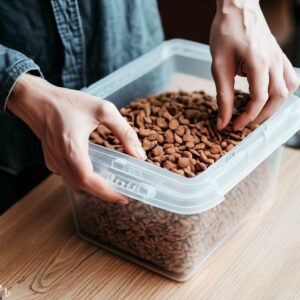
The answer to this question is not straightforward, as there are several factors that need to be considered.
Firstly, it is important to note that not all plastic containers are created equal. Some plastics can leach chemicals into the food they contain, which can be harmful to your dog’s health. Therefore, it is essential to choose a plastic container that is labelled as safe for storing food.
Secondly, the type of dog food you are storing also plays a role in determining whether or not it should be stored in a plastic container. Dry kibble can generally be stored in any type of container without any issues.
However, wet or canned dog food should always be stored in its original packaging or in an airtight container made specifically for storing wet pet food.
Thirdly, the storage conditions also matter when it comes to storing dog food in a plastic container. The container should always be kept clean and dry and away from direct sunlight and heat sources. This will help prevent bacteria growth and keep the food fresh for longer.
Lastly, it is important to regularly check the condition of the plastic container used for storing dog food. Over time, plastics can become scratched or damaged which can lead to bacteria growth and contamination of the food inside.
If you notice any signs of wear and tear on your plastic container such as cracks or scratches, it may be time to replace it with a new one.
In conclusion, while storing dog food in a plastic container may seem like an easy solution for keeping your pet’s meals fresh and organized; there are several factors that need to be considered before doing so.
-
How to keep dog food fresh in bag?
As a dog owner, it is essential to keep your furry friend’s food fresh and safe for consumption. One of the most common ways to store dog food is in a bag.
Step 1: Choose the Right Bag
The first step is to choose the right bag for storing your dog’s food. It would be best if you opted for bags made explicitly for pet food storage. These bags are designed with materials that help preserve the freshness of the food.
Step 2: Store in a Cool, Dry Place
It would be best if you store your dog’s food in a cool, dry place away from direct sunlight or heat sources. Exposure to heat or sunlight can cause the nutrients in the food to break down quickly, leading to spoilage.
Step 3: Keep It Sealed
Once you have opened the bag of dog food, make sure you seal it tightly after every use. This will prevent air from entering and causing oxidation which can lead to rancidity.
Step 4: Use an Airtight Container
If possible, transfer your dog’s food into an airtight container after opening the bag. This will provide an extra layer of protection against moisture and air exposure.
Step 5: Avoid Contamination
Make sure that any utensils or scoops used for serving your pet’s food are clean and dry before use. Also, avoid placing wet hands inside the bag as this can introduce moisture into it.
Step 6: Monitor Expiration Dates
Check expiration dates on bags of dog foods before purchasing them from stores; expired foods may cause harm when consumed by pets leading to health issues such as vomiting or diarrhea.
Step 7: Buy Smaller Bags More Often
Lastly, consider buying smaller bags of dog food more frequently. This will help ensure that your pet is always eating fresh food, and you won’t have to worry about storing large amounts for extended periods.
In conclusion, keeping your dog’s food fresh in a bag requires proper storage techniques and attention to detail. By following the seven steps and tips outlined above, you can ensure that your furry friend’s food remains safe and nutritious for consumption.
-
Is It Ok To refrigerate dry dog food?
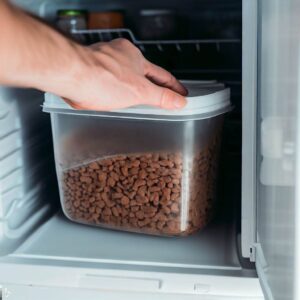
The answer to this question depends on various factors such as the type of dry dog food, storage conditions, and the duration of storage.
While some people believe that refrigerating dry dog food can help preserve its freshness and extend its shelf life, others argue that doing so can compromise the quality of the food.
Firstly, it is important to understand that dry dog food has a long shelf life and does not require refrigeration.
Some types of dry dog foods contain preservatives or antioxidants that help prevent spoilage and maintain their nutritional value for an extended period.In such cases, refrigeration may not be necessary if you store them in a cool, dry place away from direct sunlight.
However, if you live in a hot and humid climate or have limited storage space, refrigerating your dog’s food may be necessary to prevent spoilage and maintain its freshness.
Refrigeration can also help keep pests like ants and rodents away from your pet’s food.When storing dry dog food in the refrigerator, it is crucial to ensure that you use an airtight container or bag to prevent moisture from getting into the food.
Moisture can cause mold growth or bacterial contamination which can make your pet sick. It is also important to check the expiration date on the packaging before storing it in the refrigerator.
While refrigerating dry dog food may seem like a good idea, there are some downsides to consider.
For instance, when you take out cold kibble from the fridge and serve it immediately to your pet without allowing it time to warm up to room temperature first, this could cause digestive problems such as bloating or diarrhea.
It is important to note that refrigerating dry dog food can affect its texture and taste. The cold temperature can cause the kibble to become hard and lose its crunchiness.
This can make it less appealing for dogs who are used to eating fresh kibble. Additionally, if the kibble absorbs moisture from the fridge, it can become soggy and unappetizing.
Additionally, if you store wet canned dog food alongside kibble in an open container in the fridge for too long (more than 24 hours), bacteria can grow rapidly which could lead to illness for your furry friend.
In conclusion, refrigerating dry dog food is generally safe as long as you follow proper storage guidelines and take into account the type of food, storage conditions, and duration of storage.
However, it is always best to consult with your veterinarian before making any changes to your pet’s diet or feeding routine. Ultimately, the health and well-being of your furry friend should be your top priority.

